Key takeaways:
- Lighting characteristics—intensity, direction, and quality—are crucial in shaping mood and clarity in photography.
- Negative lighting tools, such as black flags and reflectors, enhance depth and contrast, significantly improving visual storytelling.
- Effective positioning and adjustments of negative lights are essential for achieving desired moods and capturing the essence of subjects.
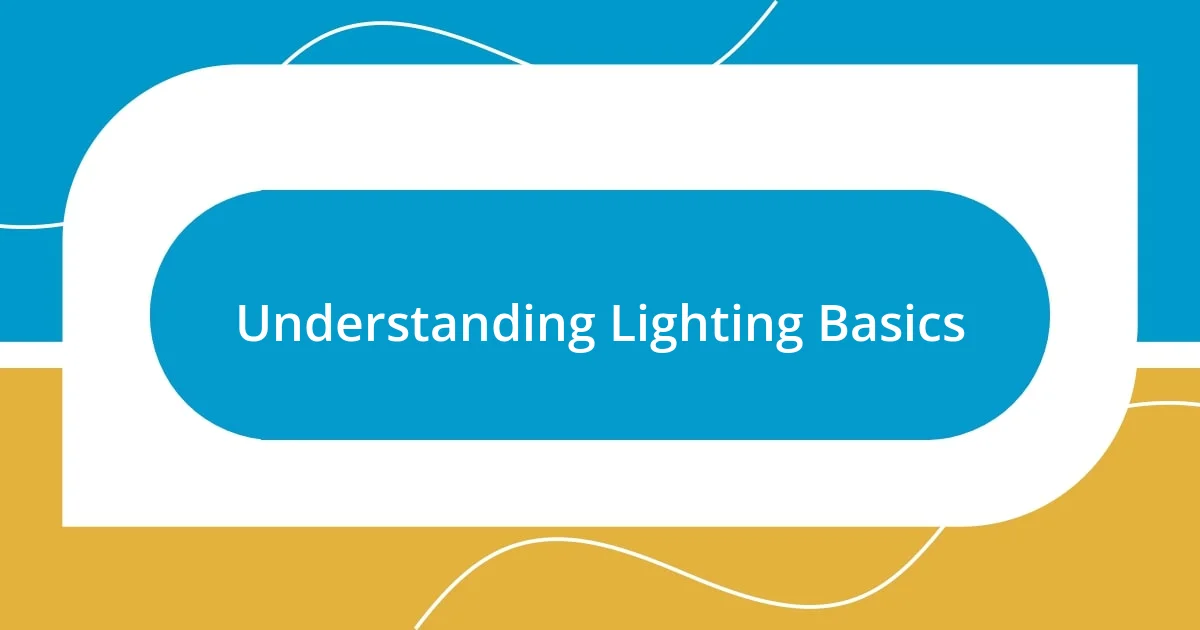
Understanding Lighting Basics
Lighting is one of the fundamental aspects of photography that can dramatically impact the mood and clarity of your images. I remember my first experience with natural light; I chased the golden hour, enchanted by how it transformed ordinary scenes into something magical. Have you ever noticed how a slight shift in light can evoke entirely different emotions?
When I think about lighting, I often consider its three main characteristics: intensity, direction, and quality. Each of these elements plays a pivotal role in shaping the final image. One time, while experimenting with a still-life setup, I realized that a soft, diffused light created a serene atmosphere, while harsh light brought an edgy, dramatic vibe. Doesn’t it make you curious about the kind of emotions you want to capture in your work?
Another key point to grasp is the interplay between light and shadow. Shadows can add depth and texture, enhancing your composition in unforeseen ways. I recall a moment when I used shadows to highlight a subject’s contours, and it felt like the image told a deeper story. How do you think shadows contribute to your visual storytelling? Exploring this relationship can truly deepen your understanding of lighting and elevate your photography to new heights.
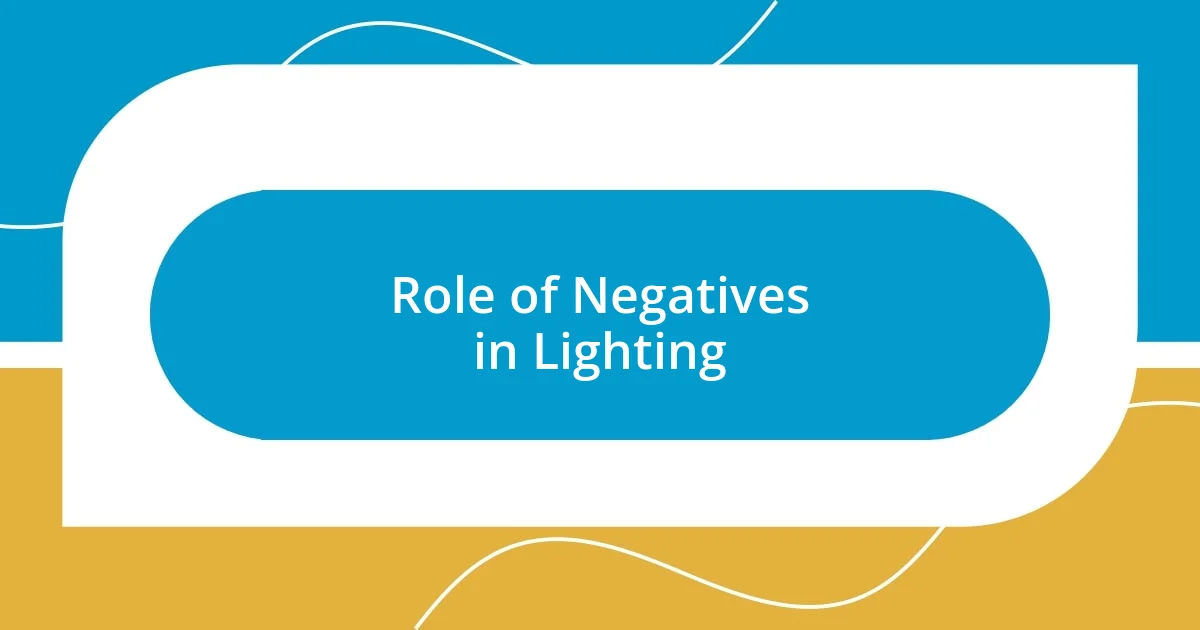
Role of Negatives in Lighting
The role of negatives in lighting is often underappreciated, yet they can transform an ordinary shot into something extraordinary. Using negative fill, for example, I’ve found that strategically placing black surfaces can absorb light and deepen shadows. I vividly recall a fashion shoot where I positioned a large black reflector opposite the main light source. It not only enhanced the model’s features but also added a sense of mystique that made the images absolutely captivating.
- Negatives help control light spill, allowing for greater focus on the subject.
- They create a sense of depth by increasing contrast between highlights and shadows.
- I often use them to evoke emotions; the darker tones can lead to introspection, while lighter shadows bring warmth.
- Employing negatives effectively can elevate the storytelling aspect of your photography, making the viewer feel connected to the subject.
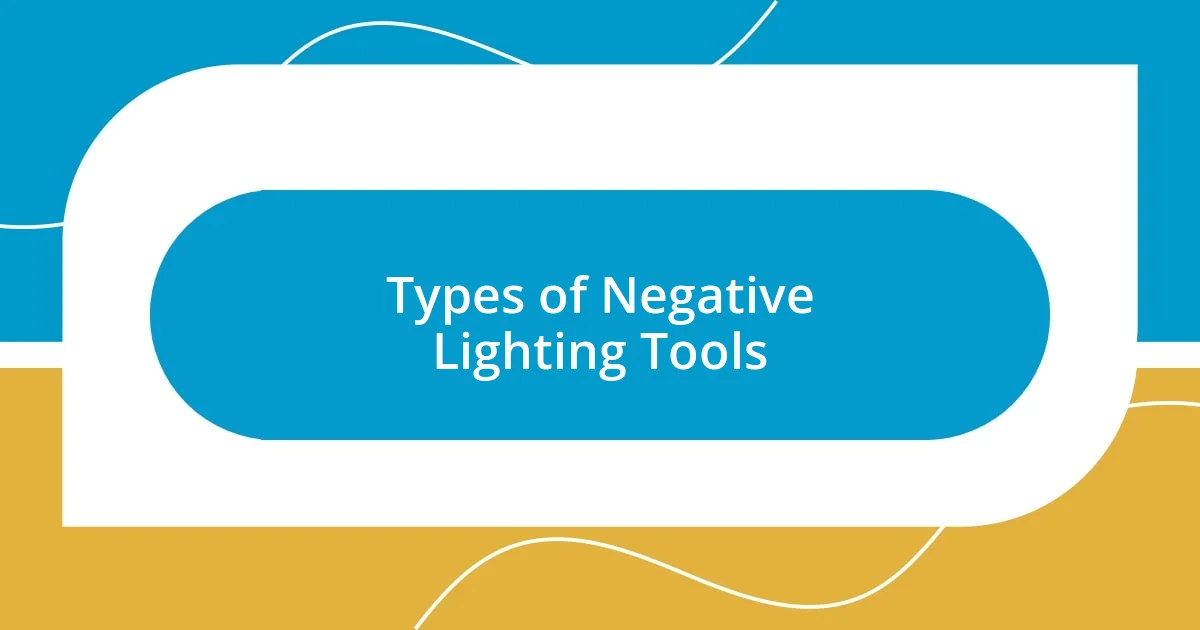
Types of Negative Lighting Tools
Using negative lighting tools can dramatically affect how we perceive an image. My go-to is often the black flag, which can fiercely block light in a way that adds incredible depth to my shots. Recently, during a portrait session, I placed a black flag just out of frame. The result was stunning; it deepened the shadows on one side of the subject’s face, creating an intense, moody effect. Have you ever tried using a flag to manipulate light? It’s like painting with shadows and can completely change the narrative.
Another fantastic negative tool I enjoy using is the black reflector. Unlike typical reflectors that bounce light back onto a subject, this absorbs light—serving as a contrast-enhancing agent. I recall one shoot where I experimented with a black reflector beneath a subject. The subtle ending of harsh highlights on their skin transformed the entire look. It brought out the texture beautifully, making it appear natural yet striking. This tool is particularly helpful when trying to create a more dramatic narrative in an otherwise bright scenario.
Finally, there are negative fill curtains, another excellent option for creating shadow areas without losing the overall ambiance. I remember setting up a shoot in a bright room and using a black curtain to slightly diffuse the overhead light. The shadows became rich and smooth, allowing the subject to stand out without overwhelming the viewer. It’s a simple trick that can lead to stunning results. Each type of negative lighting tool serves its unique purpose, giving you the freedom to craft your visual story.
| Tool | Description |
|---|---|
| Black Flag | Blocks light to enhance shadows, adding depth. |
| Black Reflector | Absorbs light, creating contrast and highlighting textures. |
| Negative Fill Curtain | Diffuses light, enriching shadows while maintaining ambiance. |
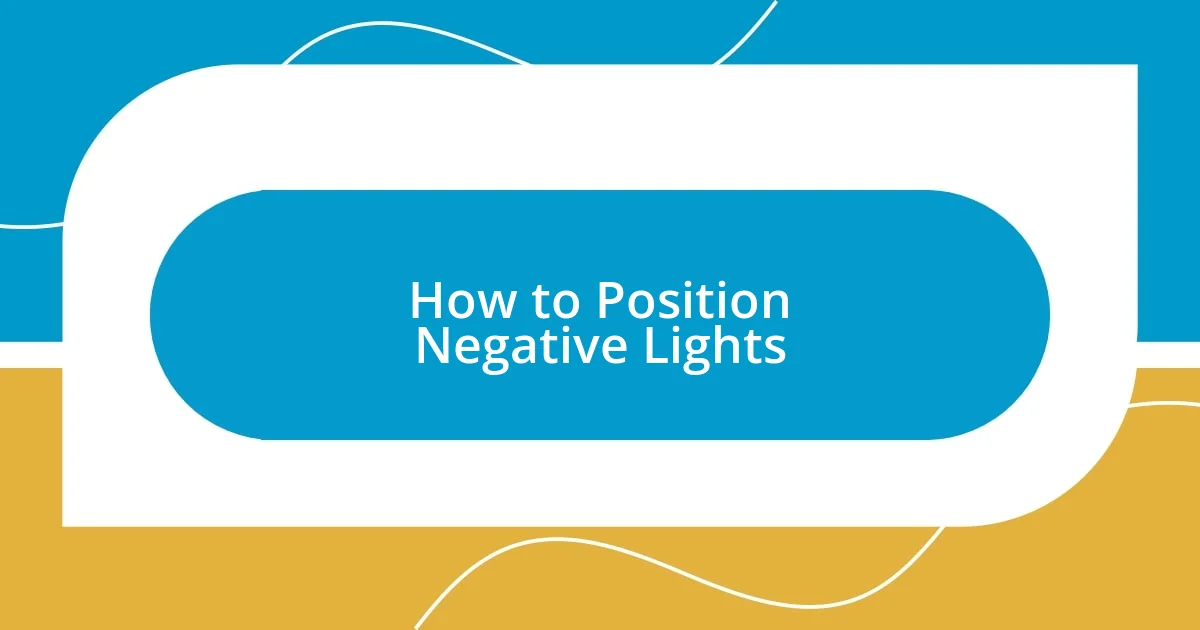
How to Position Negative Lights
When positioning negative lights, I’ve found it crucial to consider the angle and proximity to your subject. For example, during a recent still life shoot, I placed a black flag slightly above the setup and angled it down. This setup created a dramatic shadow that added intrigue to an otherwise mundane arrangement. Can you imagine how much more engaging a simple bowl of fruit can become when those shadows play off the textures?
Another effective technique involves experimenting with distance. I recall a portrait session where I positioned a black reflector about six feet away from my subject. The shadows it cast were gentle yet impactful, shaping the light with a delicate touch. This distance allowed for more subtlety in the shadows, creating a more intimate atmosphere. Have you ever tried adjusting the distance of your negatives? It can completely transform the mood of your shots.
I also recommend thinking about where the light is coming from. For instance, when faced with harsh overhead lighting, I’ll place a negative surface directly opposite the main source, which creates powerful contrast. During a candid shoot at a festival, I used this method to deepen the shadows on my subject’s face, capturing their raw emotions in a way that felt more authentic. It’s fascinating how the right positioning can draw the viewer into the moment, don’t you think?
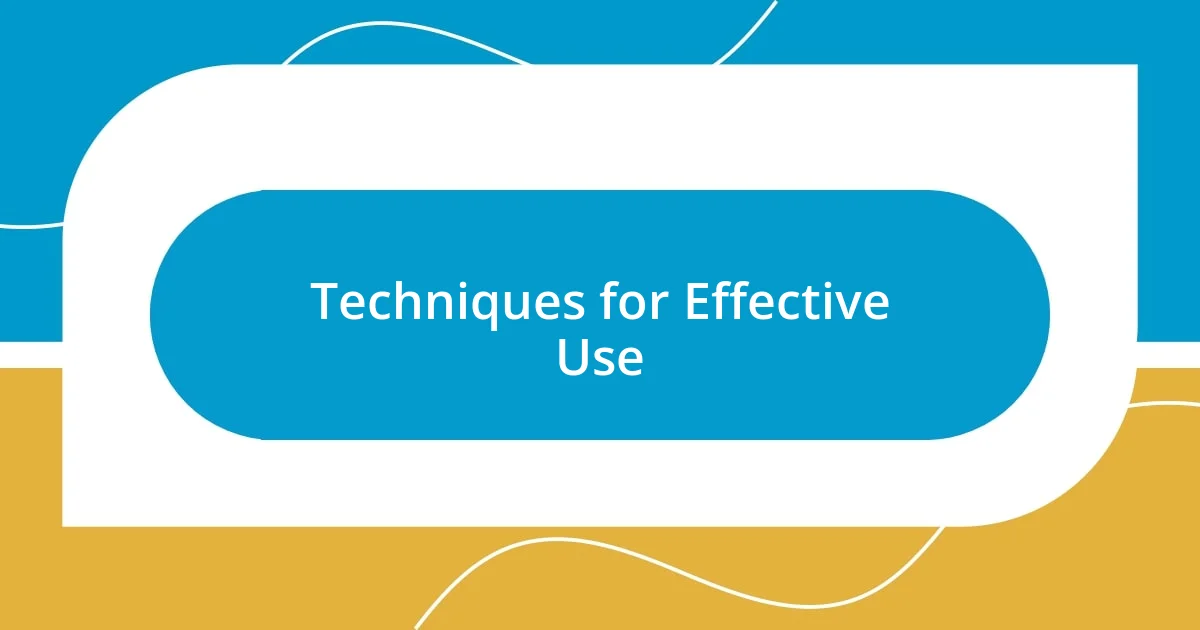
Techniques for Effective Use
One effective technique I often use is to play around with the height of my negative lighting tools. For instance, during a recent outdoor shoot at sunset, I placed a black flag low to the ground, aiming it up toward my subject. The effect was captivating, as it created elongated shadows that added drama and depth, almost like a theatrical spotlight. Have you ever noticed how height can drastically change the mood of your shot?
Experimenting with the angle can also yield impressive results. I remember a fashion shoot where I tilted a black reflector at a 45-degree angle. This simple adjustment not only softened the shadows but also added a unique flair to the overall composition. It transformed the visuals from ordinary to striking. Have you considered the power of angle when working with negatives? It’s one of those game-changing factors that can take your photography to new heights.
Another technique I’ve found invaluable is timing. On a recent trip to the beach, I utilized the golden hour to my advantage, positioning a sheer black curtain to soften the fading sunlight. The result was ethereal, casting gentle shadows that added rhythm to the waves. I couldn’t help but marvel at how light changes throughout the day and how utilizing it creatively can lead to stunning imagery. What is your favorite time of day to play with light and shadows?
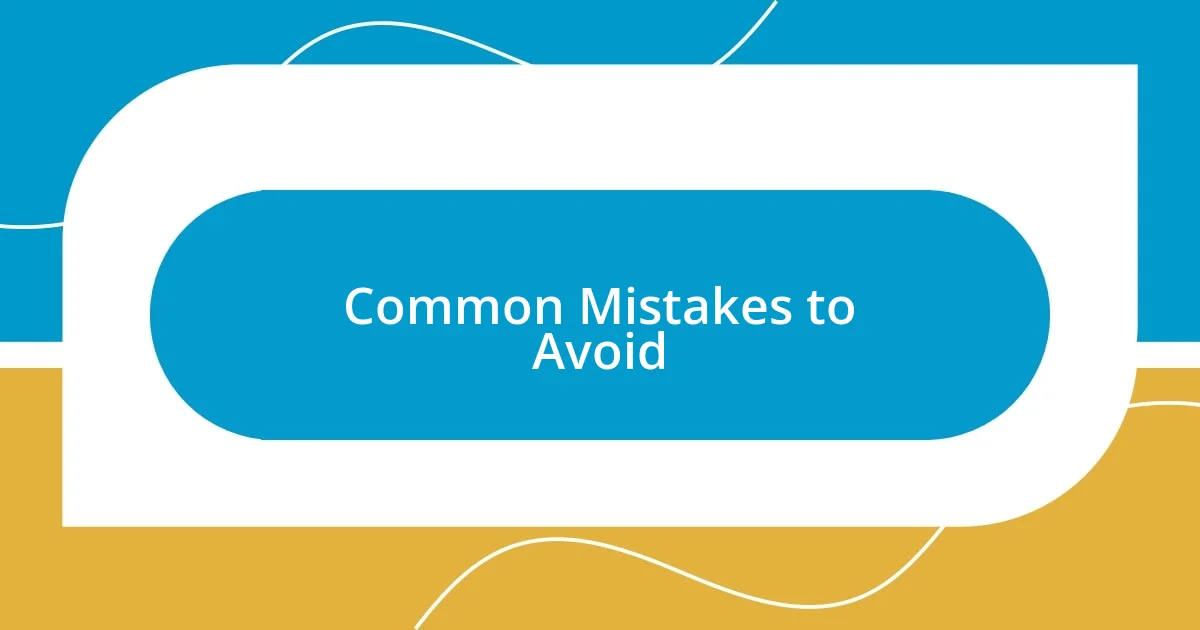
Common Mistakes to Avoid
When using negatives for lighting, one of the most common mistakes I see is neglecting the surface they are placed on. I remember mishaps from my early days where the ground was uneven or cluttered, affecting the shadows dramatically. The quality of the surface can either enhance or detract from the shadows, so always scout your location. Have you ever taken a moment to evaluate the ground beneath your setup? It can truly make a difference.
Another pitfall is over-relying on negative lights without considering the overall balance of light. I learned this the hard way during a recent portrait session. I focused solely on darkening shadows but ended up creating an unflattering look. The key is to find harmony—negative lights should sculpt rather than overshadow. Have you struck the right balance in your shots, or do you find yourself drawn to the extremes?
Lastly, ignoring the need for adjustments can lead to stale images. During an engagement shoot, I got comfortable with my initial setup and forgot to adapt as the sun shifted. The light transformed, but I kept my negatives static, resulting in flat shadows. I’ve come to realize that flexibility is vital in capturing the essence of your subject. How often do you tweak your lighting tools throughout a session to keep the creativity flowing?
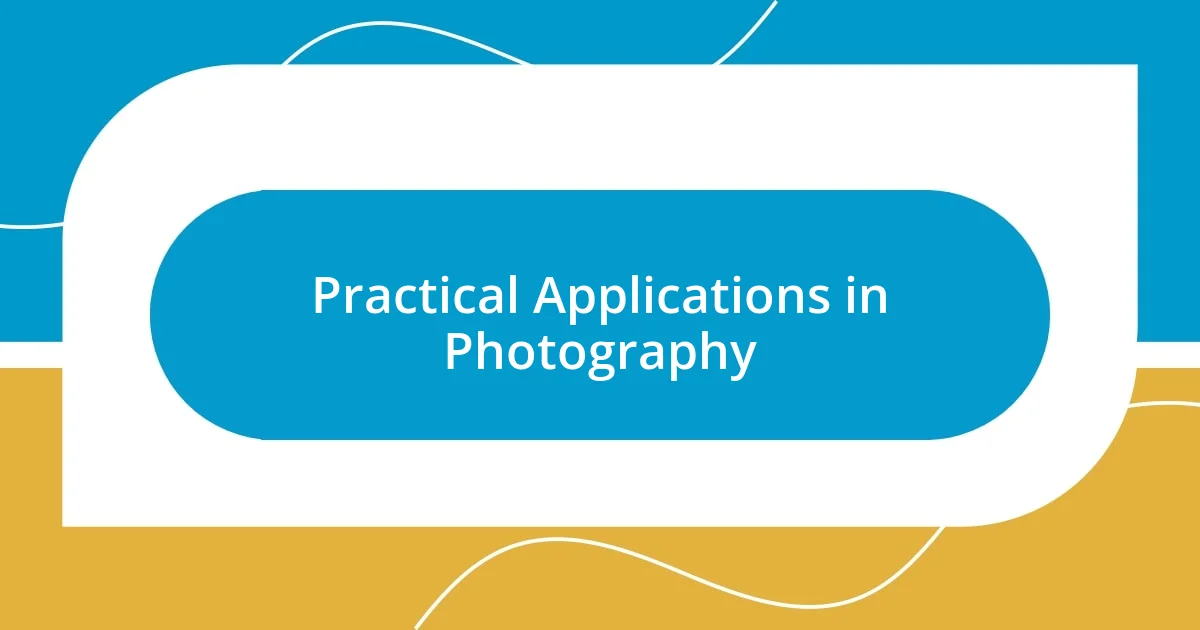
Practical Applications in Photography
When it comes to practical applications in photography, I often find that utilizing negatives can create a profound impact on the final image. For example, during a recent wedding shoot, I strategically placed a large black reflector behind the couple during golden hour. It beautifully blocked out distracting elements, allowing the warm light to wrap around them. The resulting portrait not only highlighted their features but also conveyed intimacy—have you experimented with this technique to enhance emotional storytelling in your shots?
Another instance that stands out in my memory is a dark, moody shoot with a band. I used a dark backdrop combined with negative fill to isolate the subjects amid the chaos. This approach not only emphasized the energy of the performance but also added depth to the shots. The contrast was magical, almost capturing the raw essence of the music. How do you bring out the character of your subjects using negative techniques?
I’ve also discovered that the location plays a significant role in how negatively-lit images turn out. While collaborating on an urban shoot, I found an alleyway that was perfect for experimentation. Using a black flag to block harsh sunlight, I was able to create captivating, illuminated pockets within the shadows, giving a gritty yet artistic vibe. It made me realize that exploring unique locations can open up a world of potential in your photography. Do you often seek out new environments to push your creative boundaries?














